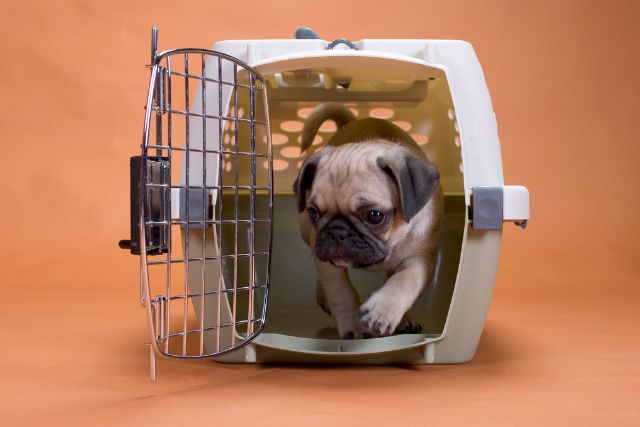Crate training is a topic that stirs debate among dog owners worldwide.
In this comprehensive guide, we’ll explore the pros and cons of using a crate, providing dog owners in Australia with all the information they need to decide whether crate training is right for their furry friends.
From enhancing safety to potentially causing anxiety, we will cover all aspects to give a balanced view.
Introduction
Crate training is a common practice among dog owners, offering a structured approach to managing a dog’s behaviour and environment.
While it has its proponents and detractors, understanding the benefits and drawbacks is crucial for making an informed decision.

Understanding Crate Training
Crate training involves teaching a dog to accept a crate or cage as a familiar and safe space.
This method leverages a dog’s natural denning instinct, providing them with a personal area where they can retreat and feel secure.
The crate can be used for various purposes, including housetraining, reducing anxiety, and managing the dog’s environment when unsupervised.
Importance for Australian Dog Owners
For Australian dog owners, crate training can be particularly beneficial due to the diverse living situations across the country.
Whether you live in a bustling city apartment or a spacious suburban home, crate training offers a versatile solution for managing your dog’s behaviour.
Moreover, with Australia’s warm climate and outdoor lifestyle, a crate can provide a cool, shaded refuge for your dog during hot days.
The Benefits of Crate Training
Exploring the positive aspects of crate training will highlight why many dog owners find this method to be an indispensable part of their pet care routine.
Creates a Safe Haven for Your Dog
A crate serves as a safe haven for dogs, offering them a dedicated space where they can relax and feel secure.
This is particularly useful for dogs that experience anxiety or stress, as the crate can provide a sense of comfort and stability.
Additionally, a crate can protect dogs from household hazards when they are unsupervised.

Assists in Housetraining and Behaviour Management
Crate training is an effective tool for housetraining puppies.
By confining the puppy to a small space, it discourages them from soiling their sleeping area, thereby teaching them to control their bladder and bowel movements.
Furthermore, a crate can be used to manage destructive behaviours by providing a controlled environment where the dog can stay safely when the owner is not home.
Facilitates Easier Travel and Boarding
For dog owners who travel frequently, crate training can make journeys less stressful for both the dog and the owner.
Dogs that are comfortable in their crates are more likely to feel secure during car rides, flights, and stays at boarding facilities.
The crate acts as a familiar environment amidst new and potentially overwhelming surroundings.
The Drawbacks of Crate Training
While the benefits are significant, it’s also critical to consider the potential negatives to ensure the well-being of your dog.
Potential for Overuse and Misuse
One of the primary concerns with crate training is the potential for overuse.
If a dog is left in the crate for extended periods, it can lead to physical and emotional issues, such as muscle atrophy, isolation, and anxiety.
It’s essential to use the crate responsibly, ensuring the dog has ample time outside the crate for exercise and social interaction.

Can Cause Stress and Anxiety in Some Dogs
While many dogs thrive with crate training, it can cause stress and anxiety in others.
Dogs that have had negative experiences with confinement or those with specific temperaments might find the crate environment distressing.
It’s crucial to introduce the crate gradually and use positive reinforcement to help the dog associate the crate with positive experiences.
Legal and Ethical Considerations in Australia
In Australia, there are legal and ethical considerations to be mindful of when crate training. Over-crating can be considered neglect, and there are regulations in place to ensure the humane treatment of animals.
Dog owners should be aware of these guidelines and strive to use crate training as a tool for positive reinforcement rather than punishment.
How to Crate Train Effectively
To successfully implement crate training, a strategic approach tailored to individual dogs’ responses and environments is crucial.
Choosing the Right Crate
Selecting the right crate is crucial for successful crate training.
The crate should be large enough for the dog to stand, turn around, and lie down comfortably but not so large that it allows for soiling in one corner.
Options include wire crates, plastic crates, and fabric crates, each offering different benefits depending on the dog’s needs and the owner’s preferences.

Step-by-Step Crate Training Process
Effective crate training involves a gradual, step-by-step approach. Start by placing the crate in a common area of the house and encouraging the dog to explore it with the door open.
Use treats and toys to create positive associations.
Gradually increase the time the dog spends in the crate, starting with short intervals and slowly extending the duration as the dog becomes more comfortable.
Common Mistakes to Avoid
Avoid using the crate as a form of punishment, as this can create negative associations and hinder the training process.
Additionally, do not force the dog into the crate or leave them confined for excessive periods.
Ensure the crate is a positive space where the dog feels safe and comfortable, and always provide plenty of opportunities for exercise, play, and social interaction outside the crate.
Expert Opinions and Case Studies
Gaining insights from veterinarians and reviewing real-life case studies will help underscore the practical implications of crate training.
Insights from Australian Veterinarians
Australian veterinarians often recommend crate training as a beneficial practice when done correctly.
They emphasize the importance of positive reinforcement, gradual introduction, and ensuring the dog’s physical and emotional needs are met.
Consulting with a vet can provide personalized advice tailored to the dog’s specific needs and temperament.

Real-Life Success Stories and Challenges
Many Australian dog owners have successfully implemented crate training, finding it an invaluable tool for managing their dogs’ behaviour.
Success stories often highlight the importance of patience, consistency, and making the crate a positive space.
Conversely, challenges usually arise from rushing the process or not providing enough time outside the crate. Learning from these experiences can offer valuable insights and tips for other dog owners.
Alternatives to Crate Training
It’s beneficial to consider alternative methods for managing a dog’s behaviour that may be more suitable for some pets and their owners.
Other Behavioural Training Methods
While crate training can be effective, it’s not the only option for managing a dog’s behaviour. Alternatives include positive reinforcement training, clicker training, and obedience classes.
These methods can help address specific behavioural issues without the need for confinement.
Using Pet Sitters and Doggy Daycare
For dog owners who are away from home for extended periods, hiring a pet sitter or enrolling the dog in doggy daycare can provide companionship and supervision without the need for a crate.
These services ensure the dog remains active, socialized, and well-cared for while the owner is away.
Frequently Asked Questions
This section addresses common queries with expert advice to clear up any misconceptions and provide useful tips for dog owners.
Answered by Professionals
Here are some common questions about crate training, answered by experts:
Q: How long can I leave my dog in the crate?
A: It’s generally recommended not to exceed 4-6 hours for adult dogs and 2-3 hours for puppies. Ensure the dog has ample time outside the crate for exercise and social interaction.
Q: What should I do if my dog whines in the crate?
A: Whining can indicate discomfort or anxiety. Ensure the dog is not left in the crate for too long, and try to make the crate a more positive space using treats and toys.
Gradual, positive reinforcement can help reduce whining over time.
Q: Can I use a crate for an older dog?
A: Yes, crate training can be beneficial for dogs of all ages. However, it may take more time and patience with older dogs, especially if they have had negative experiences with confinement in the past.

Conclusion
After examining the pros and cons of crate training, it’s clear that this method can be highly effective when used responsibly.
It provides a structured environment that can aid in housetraining, reduce anxiety, and offer a safe space for dogs.
However, it’s vital to avoid over-reliance on crates and to always prioritize the well-being of the dog.
Summary and Final Thoughts on Crate Training
Crate training offers a range of benefits, from providing a safe space for dogs to aiding in housetraining and travel. However, it’s essential to use this tool responsibly, ensuring the dog’s well-being is prioritized.
By understanding both the pros and cons and following a thoughtful, positive approach, Australian dog owners can make crate training a successful and rewarding experience for their furry friends.











